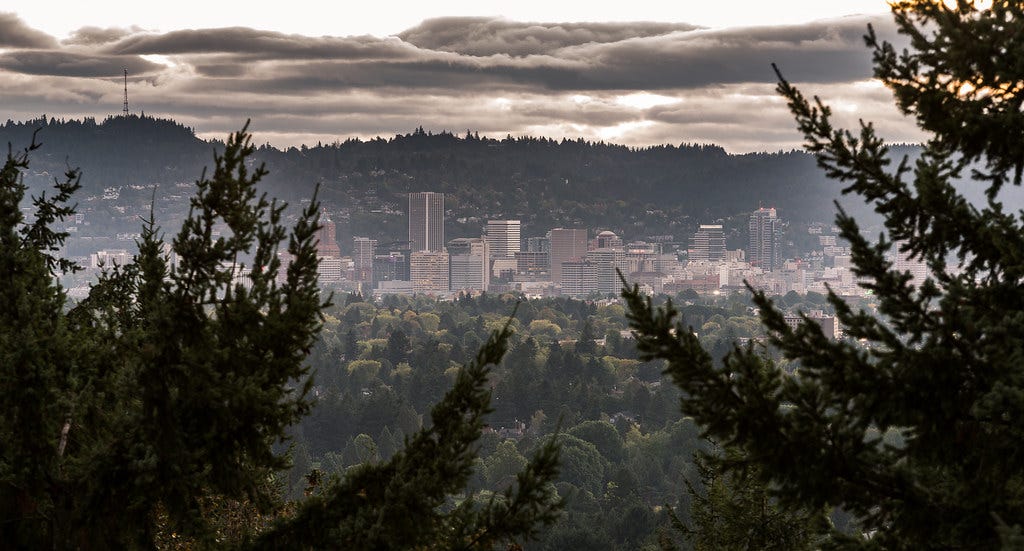John Tapogna: Don't Bet Against Portland
Portland took some big hits in 2020, but its fundamentals are strong and its prospects are bright.
John Tapogna is President of ECONorthwest, an economic consulting firm headquartered in Portland. The views expressed here are his own.

Days after September’s wildfire smoke cleared, Bloomberg’s David Shipley asked “what happened to Portland?” It was a tough time to take stock. Parts of the region were just emerging from evacuation orders, federal officers had recently pulled out of downtown, and sometimes violent, nightly protests persisted. Shipley, a Portland native, delivered a blistering critique of his hometown. He pinned the summer’s struggles on decades of political inaction, the City’s commission form of government, a series of one-term mayors, underfunded state government, an absence of a sales tax, state legislative walkouts, and no daily newspaper. The progressive, visionary city that Shipley recalled as a child was in full retreat.
Is the outlook that bleak? Is it possible that Portland has fallen that far, that fast?
A dynamic decade*
Portland had completed a dynamic decade before the pandemic started. The 1970s-era visions of walkable neighborhoods were paying off. Across the country, college-educated twentysomethings were delaying marriage and looking for urban places to meet and date. Turns out quite a few of them liked Portland.
Restaurants were key draws, and the reviews were great. The Washington Post’s food critic crowned Portland as America’s best food city in 2015, Thrillist found the best burger here in 2017, and Texas Monthly declared Portland the best barbecue scene outside of Texas last December. The restaurant praise goes on and on.
Mid-decade Portland was attracting a net 7,200 young adults each year, which put it in a “millennial magnet class” with Houston, Dallas, Austin, Denver, Seattle, and Charlotte. The in-migrants triggered an apartment building boom. The proof was visible from the skyline: Portland ranked in the top regions for the number of construction cranes.
Millennials were just part of a broader economic story, and good news didn’t end at the city limits. Nike added six new buildings to its World Headquarters in Beaverton, and employment in the footwear and apparel sector flourished across the region. Intel started and ended the decade with massive construction projects and—along with Greenbrier, Vigor, and others—contributed to a 20 percent increase in manufacturing jobs during 2009-2019. And the region’s overall job growth outpaced the nation’s year after year.
Just as businesses thrived, many individuals and families did as well. Incomes for the median, or typical, Portland household jumped to 13th nationally in 2018—up from 26th in 2010. The gains were widespread, and the region’s low-income households benefited from an increased minimum wage and tight labor market.
*That still left a lot of Portlanders behind
The decade had two critical failings. First, the expansion took too long to reach BIPOC households, and racial/ethnic income gaps grew. Second, despite the apartment building boom, housing construction didn’t keep pace with population growth, and prices soared. The 2010s were a prosperous decade that should have been more equitably shared.
The economic and cultural costs of inequality have already deepened just a year into the 2020s. The beginning of this decade will be remembered for sudden, widespread job losses and small business closures. For its lockdowns, racial justice movements, curfews, and fires. And for tear gas, toppled statutes, broken glass, and plywood.
That’s what David Shipley sees.
But it’s not the whole story.
There’s more to 2020 and beyond in Portland.

In May, while Portland was locked down, voters passed a quarter-billion-dollar measure to fund permanent supportive housing for the region’s unsheltered homeless population. Then, in August, the Portland City Council enacted one of the boldest housing reforms in U.S. history and legalized up to four homes on almost any residential lot in the city. Taken together, the initiatives represent a robust, productive response to the housing crisis.
Last month, Multnomah County voters approved universal prekindergarten for 3- and 4-year olds and, in doing so, took major strides toward equalizing life opportunities for children who grow up here. On the same ballot, Portland voters advanced rebuilding efforts at Benson, Jefferson, Wilson, and Cleveland high schools. These education investments signal that Portland’s a future-focused city that intends to grow and thrive in the decades ahead.
And while Portlanders addressed the housing crisis and invested in kids, they also put on masks, maintained social distance, and followed the advice of public health officials. To this point, collective action resulted in some of the lowest Covid-19 infection and death rates in the nation. Portland is famous for its quirkiness, but it should also be known for its community mindedness and belief in science.
Portland took some big hits in 2020, but its fundamentals are strong and its prospects are bright. Natural amenities have long been a durable advantage. But now Portland has the funding and tools to make its housing affordable and it schools great. Pull that off—implement these new programs well—and the region can look forward to an era of shared prosperity.
Don’t bet against Portland.
**************************************
Keep the conversation going:
Facebook (facebook.com/oregonway), Twitter (@the_oregon_way)
Reach out to John:
@tapogna



I enjoyed reading this. I'm just curious, now that it's 2023, how would you reflect on your hopes and predictions? I'm still incredibly distressed by the situation in Portland. What needs to happen to turn our city around?